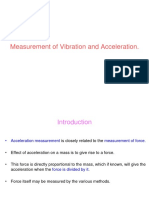Assignment-1
Uploaded by
kolathurugovardhan007Assignment-1
Uploaded by
kolathurugovardhan007INDIAN INSTITUTE OF TECHNOLOGY KHARAGPUR
DEPARTMENT OF CIVIL ENGINEERING
CE 60216: Dynamics of Soils & Foundations ASSIGNMENT # 1
ASSIGNED DATE: 14.01.2025
Answer all questions:
1. A vibration system consists of mass of 6 kg, a spring stiffness of 0.7 N/m, and a dashpot
with a damping coefficient of 2 N-s/m. Determine (a) Damping ratio, (b) Logarithmic
decrement, and (c) the amplitude of the foundation 4 cycles after it is disturbed
assuming that at time t = 0, z = 20 cm.
2. A foundation weighs 800 kN. The foundation and the soil can be approximated as a
mass-spring-dashpot system as shown in Figure Q2. The spring constant is 2105 kN/m
and. The dashpot coefficient is 2340 kN-s/m. Determine (i) critical damping (cc), (ii)
damping ratio, and (iii) the amplitude of the foundation 4 cycles after it is disturbed
assuming that at time t = 0, z = 10 cm.
Figure Q2 Figure Q3
3. In the following system shown in Figure Q3, determine the natural frequency (in Hz)
and time period (sec). Also determine the resonance frequency and magnification
factor at the operating. Given k1 = 100 N/m, k2 = 200 N/m, k3 = 100 N/m, k4 = 150 N/m
and Q0 = 100 kg and = 20 rad/sec.
4. An unknown mass of m is attached to the end of an unknown spring k has a natural
frequency 95 cps. If 1 kg mass is added to m, the natural frequency becomes equal to
75 cps. Determine the mass m in kg and spring constant k.
5. The ratio of successive amplitudes is 10 in a viscous damping apparatus. If the amount
of damping 1.5 times the previous one, what will be the ratio of successive
amplitudes?
6. A mass of 20 kg being suspended from a spring causes a static displacement of 20 mm.
Find the stiffness of the spring in N/m and natural frequency in rad/sec and time
period.
You might also like
- Solution Manual For Principles of Soil Dynamics 3rd Edition by Das PDF100% (1)Solution Manual For Principles of Soil Dynamics 3rd Edition by Das PDF8 pages
- Structural Dynamics Module 1 Assignment 1No ratings yetStructural Dynamics Module 1 Assignment 14 pages
- Soil Dynamics Assignment (Bit) : Set by Dr. Tensay Gebremedhin Page 1/2No ratings yetSoil Dynamics Assignment (Bit) : Set by Dr. Tensay Gebremedhin Page 1/22 pages
- UNIT-1 Single-Degree-Of-Freedom Linear Systems: Part - B (Long Answer Questions)No ratings yetUNIT-1 Single-Degree-Of-Freedom Linear Systems: Part - B (Long Answer Questions)6 pages
- S2-Soil Dynamics and Machine Foundation (516) .Text - MarkedNo ratings yetS2-Soil Dynamics and Machine Foundation (516) .Text - Marked2 pages
- ME3001 A4 Introductory Problems in VibrationNo ratings yetME3001 A4 Introductory Problems in Vibration2 pages
- Solution Manual Principles of Soil Dynamics 3rd Edition by Das & LuoNo ratings yetSolution Manual Principles of Soil Dynamics 3rd Edition by Das & Luo8 pages
- M2 L Vibration Acceleration MeasurementNo ratings yetM2 L Vibration Acceleration Measurement22 pages
- S2-Soil Dynamics and Machine Foundation (517) .Text - MarkedNo ratings yetS2-Soil Dynamics and Machine Foundation (517) .Text - Marked3 pages
- Principles of Soil Dynamics 3rd Edition Das Luo Solution Manual100% (45)Principles of Soil Dynamics 3rd Edition Das Luo Solution Manual40 pages
- Free Vibration Part-A: Dynamics of MachineryNo ratings yetFree Vibration Part-A: Dynamics of Machinery3 pages
- Dire Dawa University: Department of Civil Engineering100% (1)Dire Dawa University: Department of Civil Engineering3 pages
- Faculty of Engineering and Applied Science MECE 3210U - Mechanical VibrationsNo ratings yetFaculty of Engineering and Applied Science MECE 3210U - Mechanical Vibrations4 pages
- Md term - I - Ques Bank - Structural DyanamicsNo ratings yetMd term - I - Ques Bank - Structural Dyanamics3 pages
- Mech Eng 3028 Dynamics & Control II - Vibrations Assignment 1No ratings yetMech Eng 3028 Dynamics & Control II - Vibrations Assignment 13 pages
- Practice Problems Based On Free & Forced Vibrations of SDOF System100% (1)Practice Problems Based On Free & Forced Vibrations of SDOF System3 pages
- Dream: If The Roots of This Equation Are Real, Then The System Will Be A) Over DampedNo ratings yetDream: If The Roots of This Equation Are Real, Then The System Will Be A) Over Damped2 pages
- CVP 756 Structures Lab Experiment-5 Damping Ratio and Natural Frequency of Flexible SystemNo ratings yetCVP 756 Structures Lab Experiment-5 Damping Ratio and Natural Frequency of Flexible System5 pages



























































